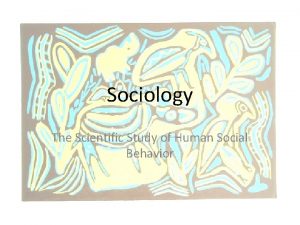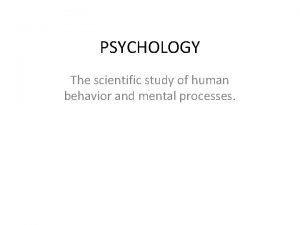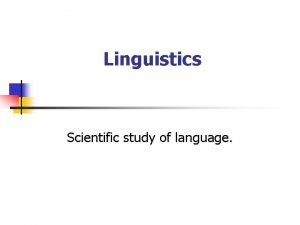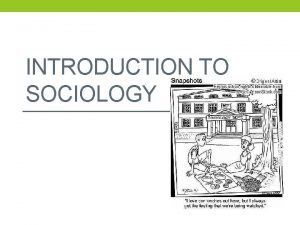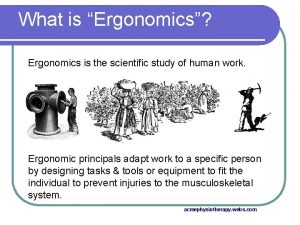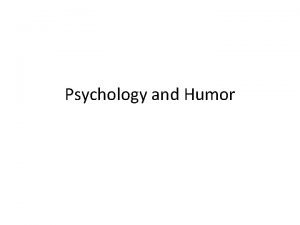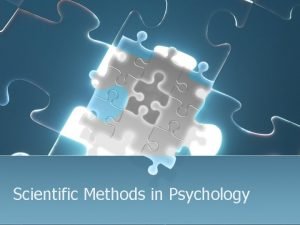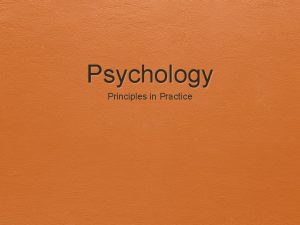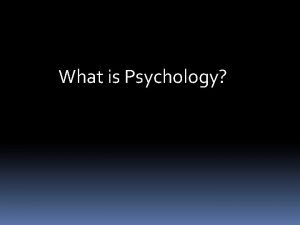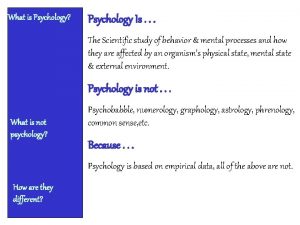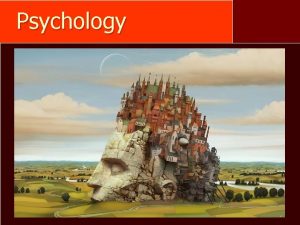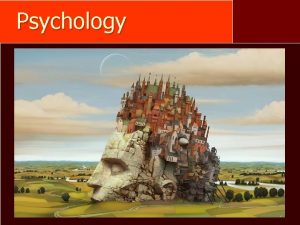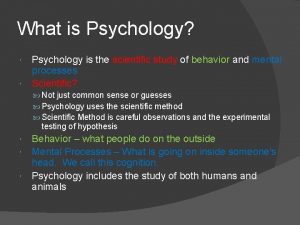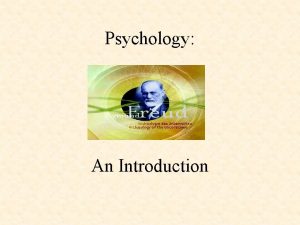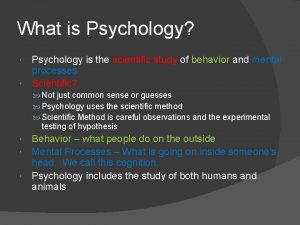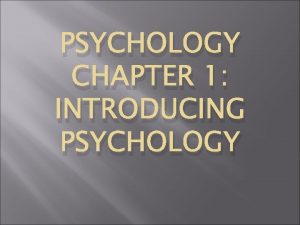Psychology and Pranking Psychology The scientific study of


























- Slides: 26

Psychology and Pranking

Psychology: The scientific study of behavior and mental processes • Scientific study – Empirical research • Experiments, observations • Behavior: observable actions/reactions – Examples? • Mental processes: internal activities – Cognitions = thoughts • Examples? – Affect/Emotion = feelings • Examples?

Psychology • In this course we will discuss some aspects of cognitive and social psychology. – Cognitive Psychology: The scientific study of human mental processes – Social Psychology: The scientific study of human behavior and mental processes as shaped by the actual, imagined, or implied presence of others

Psychology • Why is it important in the context of pranking?

Remember the Canons of Rhetoric? • Invention – concerned with finding something to say (what is gonna be said). • Use topoi (relationships among ideas) to generate something to say. • • Arrangement – concerned with how ya order communication. • • To culture jam, a lotta times ya gotta imitate the style of the jammed. Memory – concerned with remembering communication, making communication memorable, and having the ability to “off the cuff. ” • • To culture jam, ya gotta recognize the order of the jammed. Style – concerned with how ya “say” or present what you communicate (words, art, images used, use of metaphors, and stuff like that). • • Cause/effect Past/future Similarities/differences To culture jam, ya gotta figure out how to make the jam memorable to an audience. Delivery – also concerned with how ya say or present your communication (gonna have an accent, gonna stand up straight, gonna use Twitter, gonna video, gonna be live – how ya gonna deliver the information? ) • To culture jam ya gotta figure out how you are gonna deliver your communication.

Mnemonics • Mnemonic technique: A strategy that improves memory • Examples – Interactive Images – Method of Loci

Interactive Images • Create interactive images that link the isolated words in a list.

Method of Loci • Visualize walking around an area with distinctive landmarks that you know well, and then link the various landmarks to specific items to be remembered.

Memory/Mind Palace • The method of loci has been know by different names.

Let’s briefly discuss a few memory theories.

Different Memory Stores • We have three different memory stores, or sets of neurons that maintain information • Each memory store has a different… – Duration: the length of time information is maintained – Capacity: the amount of information that is maintained – Theory of Forgetting: how information is lost

Different Memory Stores • Fundamental distinctions among memory stores were first characterized by Atkinson and Shiffrin – Three-Stage Model of Memory (Modal Model)

The Atkinson & Shiffrin Thee-Stage Memory Model SM STM LTM Capacity Quite Large 7+/ - 2 chunks Quite Large Duration 100 -250 msec 10 -30 secs Forgetting Decay Interference Lifetime Retrieval Failure

Levels of Processing (Craik & Lockhart, 1972) • Info processing at varying levels of depth – Deep Processing: Meaning and importance – Shallow Processing: Surface forms of items • Deep Processing results in greater memory • Depth is a continuum – Structural: The properties of the stimulus word • Shallow • HOW MANY VOWELS DOES THE WORD HAVE? – Phonemic: The sound of the spoken word • Intermediate • WHAT IS A WORD THAT RHYMES WITH THIS WORD? – Semantic: The meaning of the word • Deep • DOES THE WORD FIT IN THIS SENTENCE? : THERE WAS A _____ ON THE SIDE OF THE ROAD.

Paivio’s Dual Coding Theory • Dual coding theory – memory is improved when items can be stored as verbal and visual codes – Makes memory better – You can forget one without forgetting the other

Improving Memory • Engage in deep processing (elaborative rehearsal) – Semantic encoding • Understand what material means

Improving Memory • Engage in deep processing (elaborative rehearsal) – Self-referencing encoding • Make material personally meaningful

Improving Memory 18 • Information on any given topic will be remembered better by individuals who have great interest in it than those who don’t – e. g. , the Swazi’s of South Africa superior memory for information about cows (Bartlett, 1932) • Interest in a topic is positively associated with pre -existing knowledge and schemas into which new information can be integrated – e. g. , existing soccer knowledge correlates highly with the ability to remember made-up soccer scores (Morris et al. , 1981)

Improving Memory • Engage in deep processing (elaborative rehearsal) – Make the information distinct • Primary distinctiveness – item is distinct from other items in the immediate context – cup saucer plate fork spoon knife bowl • Secondary distinctiveness – distinct from items stored in LTM – Orthographic distinctiveness – lowercase words that have an unusual shape – lymph, khaki, afghan LYMPH, KHAKI, AFGHAN • Emotional distinctiveness – items that produce an intense emotional reaction • Processing distinctiveness – creation of a memory code that makes that memory distinct from others

Improving Memory • Engage in adequate rehearsal – Repetition (maintenance rehearsal) is not enough – Testing effect • Doing practice questions increases retention – Expanding retrieval • Each item should be tested at the longest interval at which it can be reliably recalled

21 Mind Maps • Mind Map: – A notetaking/brainstorming strategy consisting of a diagram, including: • A central idea • Related ideas – More closely related concepts are located closer to the central concept • Links connecting them • Buzan and Buzan (1993)

22 Benefits of Mind Maps • Presumed Benefits – Encourage active learning – More natural than linear note taking – Ideas are distilled to their core, leaving out unimportant details – Visual images may be easier to remember – Color coding can be used to indicategory relations • Empirical Benefits – Farrand, Hussaine, and Hennessy (2002) • Task: – Learn the material by: » Mind mapping » Usual study techniques – Tested 1 week later • Results: – Mind-mapping group recalled 10% more » Even though mind mappers had less motivation for their technique

Improving Memory • Study in the state/context you will be tested Gooden & Baddeley (1975)

How can you improve the memory of other individuals?

How can you make a prank more memorable?

What if your audience doesn’t want to learn the information?
 Social psychology definition psychology
Social psychology definition psychology Information gathered during an experiment
Information gathered during an experiment How is a scientific law different from a scientific theory?
How is a scientific law different from a scientific theory? Scientific study of social behavior and human groups
Scientific study of social behavior and human groups The scientific study of behavior and mental processes
The scientific study of behavior and mental processes Linguistics as a scientific study of language
Linguistics as a scientific study of language Sociology is the scientific study of
Sociology is the scientific study of The scientific study of trees
The scientific study of trees Finished files are the result of
Finished files are the result of What is ergonomics
What is ergonomics The scientific study of heredity *
The scientific study of heredity * Hình ảnh bộ gõ cơ thể búng tay
Hình ảnh bộ gõ cơ thể búng tay Bổ thể
Bổ thể Tỉ lệ cơ thể trẻ em
Tỉ lệ cơ thể trẻ em Gấu đi như thế nào
Gấu đi như thế nào Chụp tư thế worms-breton
Chụp tư thế worms-breton Bài hát chúa yêu trần thế alleluia
Bài hát chúa yêu trần thế alleluia Kể tên các môn thể thao
Kể tên các môn thể thao Thế nào là hệ số cao nhất
Thế nào là hệ số cao nhất Các châu lục và đại dương trên thế giới
Các châu lục và đại dương trên thế giới Công thức tính thế năng
Công thức tính thế năng Trời xanh đây là của chúng ta thể thơ
Trời xanh đây là của chúng ta thể thơ Mật thư tọa độ 5x5
Mật thư tọa độ 5x5 Làm thế nào để 102-1=99
Làm thế nào để 102-1=99 độ dài liên kết
độ dài liên kết Các châu lục và đại dương trên thế giới
Các châu lục và đại dương trên thế giới



